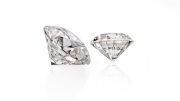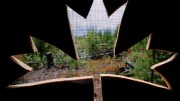A new mine plan that incorporates revisions to mineral resource estimates completed in 2013 and 2015 adds three additional years of production to Stornoway Diamond’s (TSX: SWY) Renard project, which will become Quebec’s first-ever diamond mine when commercial production kicks off in December.
The plan, released just six months before the first ore is scheduled to be processed at the end of September, has extended the mine life to 14 years from 11 years, based on a 24% increase in probable reserves.
“We’re progressively converting pieces of the large resource inventory to the mineral reserve and into the mine plan,” Matt Manson, Stornoway’s president and CEO, says of the diamond project, 350 km north of Chibougamau in the James Bay region.
“We’ve updated our resource statement twice since we put out the feasibility study in 2013 and so we have a larger indicated resource that fed through to the mine plan and into reserves.”
Probable reserves have grown to 22.3 million carats in 33.4 million tonnes averaging 0.67 carat per tonne from 17.9 million carats in 23.8 million tonnes averaging 0.75 carat per tonne. The lower grade is due to the addition of new lower grade material within the open pit and underground mining envelopes.
Stornoway is also five months ahead of schedule and $36 million under budget. In April 2014, the project’s capital cost to complete was estimated at around $811 million. Now it’s down to $775 million, including all costs, contingencies and escalation allowances.
“When we started construction in July 2014 the schedule was to achieve commercial production in May 2017 at a capital cost of $811 million,” Manson says. “On February 3, we announced that we were ahead of schedule and that we would be coming in with the first ore in September 2016 and commercial production by December 31 — five months ahead of schedule. That’s hugely important.”
Manson puts the company’s development success down to execution.
“We’ve been able to move very quickly and so that’s why we’re ahead of schedule and below budget — we’re doing everything faster and there is a savings in doing everything faster.”
It’s also helped that few other projects are being built in the mining space, so there’s been less competition for resources.
“We’ve really been able to capture a lot of efficiencies that are in the current construction market,” he notes. “We’ve had a free run at suppliers, at contractors, and people, and so we’ve been able to move very quickly.”
In addition, Stornoway has benefited from a weak Canadian dollar as some of the money it raised to build Renard was in U.S. dollars.
Under the revised mine plan, Renard will produce 1.8 million carats per year in years one through ten, up from the previously estimated 1.6 million carats.
In 2018, the processing rate is scheduled to rise from 2.2 million tonnes a year or 6,000 tonnes per day to 2.5 million tonnes a year – 7,000 tonnes per day.
Life-of-mine average operating costs are anticipated to be about $56.20 per tonne or $84.37 per carat.
Mining operations in the Renard 2 and 3 open pits, which began last year, are expected to provide the bulk of ore production until 2018, when production from the underground mine is expected to start. Underground ore will be taken from the Renard 2 kimberlite only between 2018 and 202 and from Renard 3 and 4 between 2027 and 2029.
“The Renard project is on track and getting better,” Eric Lemieux of Pear Tree Securities, commented in a research note.
Stornoway is confident there remains a lot of exploration upside, too. Five kimberlites make up the resource — Renard 2, Renard 3, Renard 4, Renard 65 and Renard 9 — and all of them remain open at depth.
“We believe there’s a lot of additional ore that can be mined below the current mineral reserve and that holds true for all of the ore bodies,” Manson says. “Renard 2 is the biggest and has one of the highest grades, so that’s been the focus, but there are five ore bodies in the current mineral resource and four in the current mineral reserve and all of them are open at depth and all of them are mineable grades.”
At Renard 2, Stornoway has defined mineral reserves down to a depth of 700 metres but Manson says they company knows there’s more below that level.
“That’s as deep as we can expect with the ramp that we’ve got, but we know the orebody goes down to below 1,000 metres, and at that depth it’s about a one hectare cross-sectional area,” he explains. “This is about one hectare at surface and 1.6 hectares at 600 metres, so it’s like a tube with a bulge in the middle.”
In addition, the project continues to demonstrate a robust valuation and a cash operating margin of 59% after all taxes, royalties and the Renard diamond stream, despite the substantial recent reduction in rough diamond prices, he points out.
According to roughprices.com, there has been a 19% decline in price for rough diamonds between March 2014 and March 2016. Stornoway expects diamond prices will rise by 2.5% a year between now and the end of 2028.
Over the last year, Stornoway has traded within a range of 62¢ and $1.08 on the Toronto Stock Exchange. At presstime shares were trading at $1.04 apiece.
— Trish Saywell is a senior staff writer with The Northern Miner.






Be the first to comment on "Stornoway adds three years to mine life at Renard"